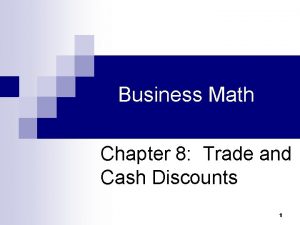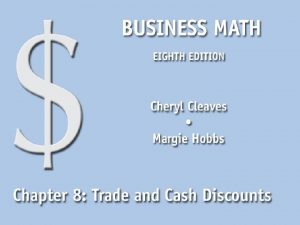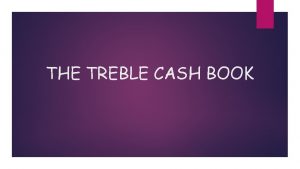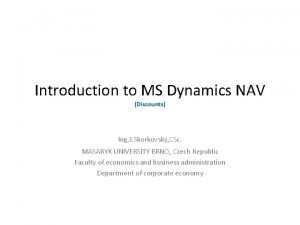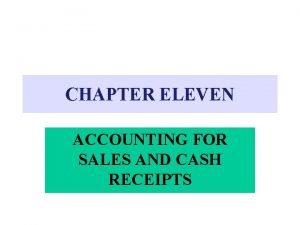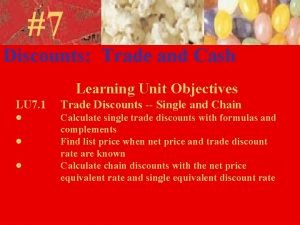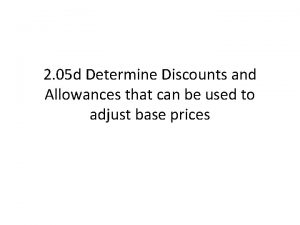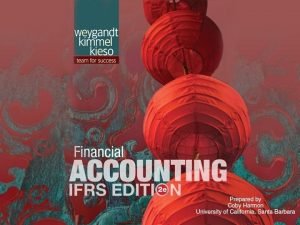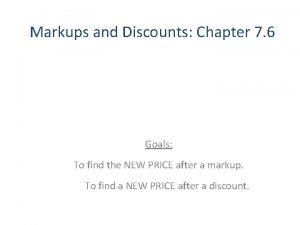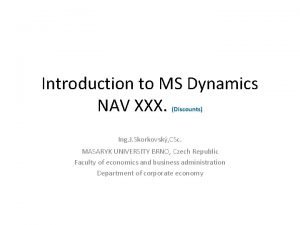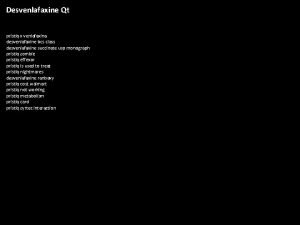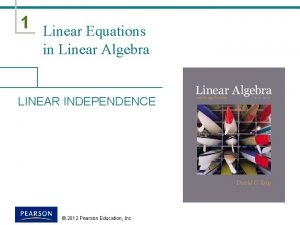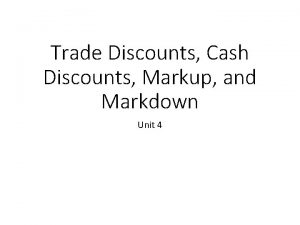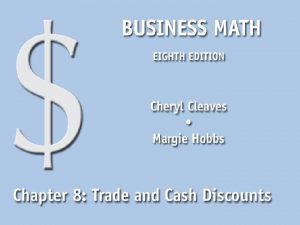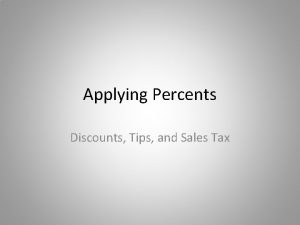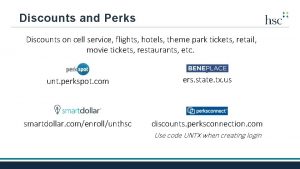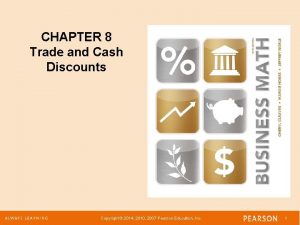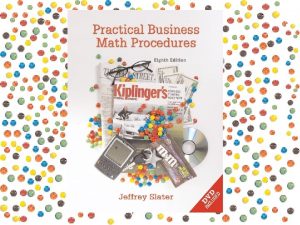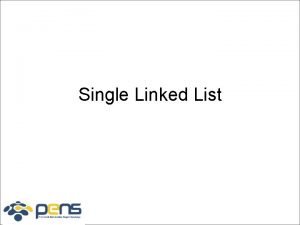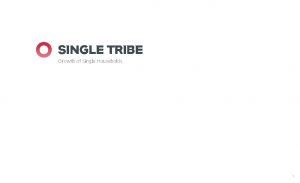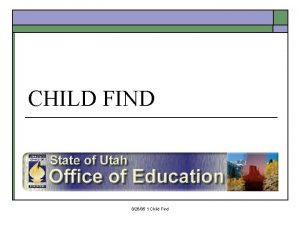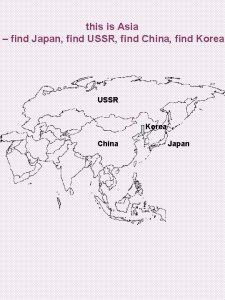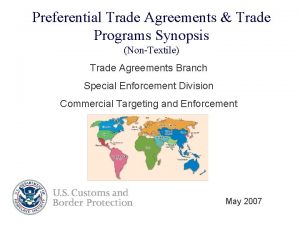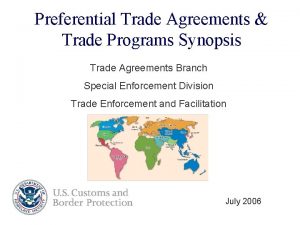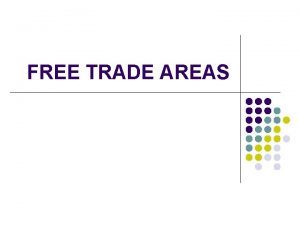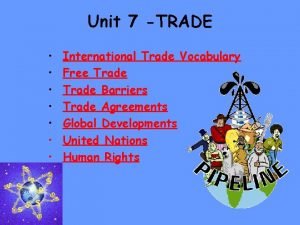8 1 Single Trade Discounts n Find the












































- Slides: 44


8. 1 Single Trade Discounts n Find the trade discount using a single trade discount rate; find the net price using the trade discount. n Find the net price using the complement of the single trade discount rate. Business Math, Eighth Edition Cleaves/Hobbs © 2009 Pearson Education, Inc. Upper Saddle River, NJ 07458 All Rights Reserved

Key Terms n Suggested retail price, catalog price, list price: three common terms for the price which the manufacturer suggests an item be sold to the consumer. n Trade discount: the amount of discount that the wholesaler or retailer receives off the list price or the difference between the list price and the net price Business Math, Eighth Edition Cleaves/Hobbs © 2009 Pearson Education, Inc. Upper Saddle River, NJ 07458 All Rights Reserved

Key Terms n Net price: the price the manufacturer or retailer pays or the list price minus the trade discount. n Discount rate: a percent of the list price. Business Math, Eighth Edition Cleaves/Hobbs © 2009 Pearson Education, Inc. Upper Saddle River, NJ 07458 All Rights Reserved

Product flow Manufacturer Wholesaler Retailer Consumer Business Math, Eighth Edition Cleaves/Hobbs © 2009 Pearson Education, Inc. Upper Saddle River, NJ 07458 All Rights Reserved

Price flow Consumer List Price $80 Retailer Wholesaler Net Price $56 30% off list Business Math, Eighth Edition Cleaves/Hobbs $40 Manufacturer Cost $20 50% off list © 2009 Pearson Education, Inc. Upper Saddle River, NJ 07458 All Rights Reserved

How to find the trade discount n Using a single trade discount rate: 1. Identify the single discount rate and the list price. 2. Multiply the list price by the single discount rate. n Trade discount = rate x list price Business Math, Eighth Edition Cleaves/Hobbs © 2009 Pearson Education, Inc. Upper Saddle River, NJ 07458 All Rights Reserved

Look at this example n Trade discount = rate x list price Find the trade discount for a cd player that retails at $120 and has a trade discount rate of 35%. n Trade discount = 0. 35 x $120 Trade discount = $42 What does the $42 mean? That the wholesaler or retailer will not pay $42 of the $120 list price. n n n Business Math, Eighth Edition Cleaves/Hobbs © 2009 Pearson Education, Inc. Upper Saddle River, NJ 07458 All Rights Reserved

Try these examples n Find the trade discount for a rug that lists for $290 and has a trade discount of 30%. n n $87 Find the trade discount for styling gel that lists for $18 and has a trade discount of 15%. n Business Math, Eighth Edition Cleaves/Hobbs $2. 70 © 2009 Pearson Education, Inc. Upper Saddle River, NJ 07458 All Rights Reserved

Find the net price n Using the trade discount: 1. Identify the list price and the trade discount. 2. Subtract the trade discount from the list price. Trade discount = Rate x List Price Net Price = List Price – Trade discount Business Math, Eighth Edition Cleaves/Hobbs © 2009 Pearson Education, Inc. Upper Saddle River, NJ 07458 All Rights Reserved

Look at this example n Find the net price of a desk that lists for $320 and has a trade discount of 30%. n Trade discount = 0. 30 x $320 = $96 n Net price = List price – Trade discount n Net price = $320 - $96 = $224 Business Math, Eighth Edition Cleaves/Hobbs © 2009 Pearson Education, Inc. Upper Saddle River, NJ 07458 All Rights Reserved

Try these examples n Find the net price of a camera that lists for $240 and has a trade discount of 45%. n n $132 Find the net price of a patio table that lists for $460 and has a trade discount of 20%. n Business Math, Eighth Edition Cleaves/Hobbs $368 © 2009 Pearson Education, Inc. Upper Saddle River, NJ 07458 All Rights Reserved

Find the net price n Using the complement of the single trade discount rate. n Complement of percent: the difference between 100% and the given percent. n Examples: ¡ The complement of 30% is 70%. ¡ The complement of 55% is 45% ¡ The complement of 5% is 95%. Business Math, Eighth Edition Cleaves/Hobbs © 2009 Pearson Education, Inc. Upper Saddle River, NJ 07458 All Rights Reserved

How to find the net price 1. Find the complement: subtract the single trade discount from 100%. 2. Multiply the list price by the complement of the single trade discount. Example: Find the net price of a coffee maker that lists for $20 and has a trade discount rate of 20%. 80% is the complement of 20% NP = $20 x 0. 80 = $16 Business Math, Eighth Edition Cleaves/Hobbs © 2009 Pearson Education, Inc. Upper Saddle River, NJ 07458 All Rights Reserved

Try these examples n Find the net price of a set of golf clubs that lists for $1, 500 and has a trade discount of 15%. n n $1275 Find the net price of a bicycle that lists for $102 and has a trade discount of 30%. n Business Math, Eighth Edition Cleaves/Hobbs $71. 40 © 2009 Pearson Education, Inc. Upper Saddle River, NJ 07458 All Rights Reserved

8. 2 Trade Discount Series n Find the net price, applying a trade discount and using the net decimal equivalent. n Find the trade discount, applying a trade discount series and using the single discount equivalent. Business Math, Eighth Edition Cleaves/Hobbs © 2009 Pearson Education, Inc. Upper Saddle River, NJ 07458 All Rights Reserved

Trade discount series n Trade discount series or chain discount: additional discounts that are deducted one after another from the list price. n Reasons to use discount series include: ¡ To encourage volume purchases ¡ To promote special or seasonal items ¡ To entice a new client Business Math, Eighth Edition Cleaves/Hobbs © 2009 Pearson Education, Inc. Upper Saddle River, NJ 07458 All Rights Reserved

Trade discount series step by step n An item lists for $400 and has a discount of 20%. $400 x 0. 2 = $80; $400 - $80 = $320 n An additional discount of 10% is taken on the previous price. $320 x 0. 1 = $32; $320 - $32 = $288 n An additional discount of 5% is taken on the previous price. $288 x 0. 05 = $14. 40; $288 - $14. 40 = $273. 60 n $273. 60 is the final price Business Math, Eighth Edition Cleaves/Hobbs © 2009 Pearson Education, Inc. Upper Saddle River, NJ 07458 All Rights Reserved

Can you add the discounts together and apply it as one? n If the item has three discounts of 20%, 10% and 5%, can you add them together and apply a 35% discount? n No, because each time you apply the additional discount, the base becomes smaller. Directly applying a 35% discount would result in a final price of $260 ≠ $273. 60 Business Math, Eighth Edition Cleaves/Hobbs © 2009 Pearson Education, Inc. Upper Saddle River, NJ 07458 All Rights Reserved

The net decimal equivalent n To find the net decimal equivalent of a trade discount series: 1. Find the net decimal equivalent: multiply the decimal form of the complement of each trade discount rate in a series. 2. Multiply the list price by the net decimal equivalent. Business Math, Eighth Edition Cleaves/Hobbs © 2009 Pearson Education, Inc. Upper Saddle River, NJ 07458 All Rights Reserved

Look at this example n Find the net price of an order with a list price of $800 and a trade discount series of 20/10/5. n Find the complement of each of the trade discount rates. n They are 0. 80, 0. 90 and 0. 95. Multiply them together. n The net decimal equivalent is 0. 684 n Apply the net decimal equivalent to the list price. n NP = 0. 684 x $800 = $547. 20 Business Math, Eighth Edition Cleaves/Hobbs © 2009 Pearson Education, Inc. Upper Saddle River, NJ 07458 All Rights Reserved

Try these examples n A tool set lists for $325 and has a trade discount series of 20/10/10. Find the net price. $210. 60 n n A dress shirt lists for $125 and has a trade discount series of 15/10/7. 5. Find the net price. n Business Math, Eighth Edition Cleaves/Hobbs $88. 45 © 2009 Pearson Education, Inc. Upper Saddle River, NJ 07458 All Rights Reserved

8. 2. 2 Find the Trade Discount To find the trade discount by applying a trade discount series and using the single discount equivalent: 1. Find the single discount equivalent by subtracting the net decimal equivalent from “ 1. ” 2. Multiply the list price by the single discount equivalent. TD = single discount equivalent x list price Business Math, Eighth Edition Cleaves/Hobbs © 2009 Pearson Education, Inc. Upper Saddle River, NJ 07458 All Rights Reserved

Key Terms n Single discount equivalent: the complement of the net decimal equivalent. It is the decimal equivalent of a single discount rate that is equal to the series of discount rates. n Total amount of a series of discounts = single discount equivalent x list price n Net amount you pay = net decimal equivalent x list price Business Math, Eighth Edition Cleaves/Hobbs © 2009 Pearson Education, Inc. Upper Saddle River, NJ 07458 All Rights Reserved

Look at this example n Use the single discount equivalent to calculate the trade discount on a $3, 200 lawn tractor with a discount series of 30/20/10. n Find the net decimal equivalent by multiplying the complements of each discount rate. 0. 70 x 0. 80 x 0. 90 = 0. 504 n To find the single discount equivalent, subtract the net decimal equivalent from “ 1. ” Business Math, Eighth Edition Cleaves/Hobbs © 2009 Pearson Education, Inc. Upper Saddle River, NJ 07458 All Rights Reserved

Look at this example (continued) n Subtract the net decimal equivalent (0. 504) from “ 1” to find the single discount equivalent. n The result is 0. 496 (or 49. 6%). n The single discount equivalent is 0. 496; apply it to the price of $3, 200. n TD = $3, 200 x 0. 496 = $1, 587. 20 n The trade discount on the tractor is $1, 587. 20. That is the amount that you do not pay. Business Math, Eighth Edition Cleaves/Hobbs © 2009 Pearson Education, Inc. Upper Saddle River, NJ 07458 All Rights Reserved

8. 3 Cash Discount and Sales Terms n Find the cash discount and the net amount using ordinary dating terms n Interpret and apply EOM terms n Interpret and apply ROG terms n Find the amount credited and the outstanding balance from partial payments n Interpret freight terms Business Math, Eighth Edition Cleaves/Hobbs © 2009 Pearson Education, Inc. Upper Saddle River, NJ 07458 All Rights Reserved

8. 3. 1 Find the Cash Discount and the Net Amount n Bills are often due within thirty days from the date of the invoice. n To encourage prompt payment, companies offer an incentive of a cash discount if the invoice is paid within a specified period. n “ 2/10 n/30” means “take a 2% cash discount if paid within 10 days; pay the net price if covered within 30 days. ” Business Math, Eighth Edition Cleaves/Hobbs © 2009 Pearson Education, Inc. Upper Saddle River, NJ 07458 All Rights Reserved

Look at this example n Find the cash discount for an invoice dated December 1 for $1, 500 with terms of 2/10 n/30. n If the invoice is paid on December 9 th, for example, the payment would include the discount and the amount would be $1, 470. n If the invoice is paid on or after December 11 th, the amount to pay would be $1, 500. Business Math, Eighth Edition Cleaves/Hobbs © 2009 Pearson Education, Inc. Upper Saddle River, NJ 07458 All Rights Reserved

Try these examples Annie’s Plants has received an invoice for $450. 00 for potting soil dated November 3 with terms of 5/10 n/30. If the invoice is paid on November 12, how much would Annie’s pay? n n $427. 50 n What if the bill is paid on November 30? n They would not be able to take the discount and would have to pay the full amount of $450. Business Math, Eighth Edition Cleaves/Hobbs © 2009 Pearson Education, Inc. Upper Saddle River, NJ 07458 All Rights Reserved

“Thirty days has September…” n To calculate the exact number of days for a cash discount, you must know how many days are in each month, so if you are not sure…learn them. n There are two tips in the text to help you; using a chart is usually the most reliable. Business Math, Eighth Edition Cleaves/Hobbs © 2009 Pearson Education, Inc. Upper Saddle River, NJ 07458 All Rights Reserved

Use the complement to find the net amount of an invoice n An invoice of $500 which reads 2/10 n/30 tells you that a discount of 2% is available if the payment is made within 10 days. n To calculate the net amount directly, use the complement of the discount (in this case, 0. 98) and multiply it by the total amount. n $500 x 0. 98 = $490 = net amount to be paid Business Math, Eighth Edition Cleaves/Hobbs © 2009 Pearson Education, Inc. Upper Saddle River, NJ 07458 All Rights Reserved

Try this example n Sycamore Enterprises received a $1, 248 bill for computer supplies dated September 2 with sales terms of 2/10, 1/15, n/30. A 5% penalty is charged after 30 days. Find the amount due for the following dates: September 12, September 15, October 1, October 3. n September 12 (2% discount) = $1, 223. 04 n September 15 (1% discount) = $1, 235. 52 n October 1 (no discount) = $1, 248. 00 n October 3 (5% penalty) = $1, 310. 40 Business Math, Eighth Edition Cleaves/Hobbs © 2009 Pearson Education, Inc. Upper Saddle River, NJ 07458 All Rights Reserved

8. 3. 2 Interpret and Apply EOM (end-of-month) Terms n Another type of sales term are EOM terms. n For example, an invoice might be 2/10 EOM, meaning that a 2% discount is allowed if the bill is paid during the first month or up until 10 days of the month after the month on the date of the invoice. n If the invoice is dated November 19, then the 2% discount is allowed up to and including December 10. Business Math, Eighth Edition Cleaves/Hobbs © 2009 Pearson Education, Inc. Upper Saddle River, NJ 07458 All Rights Reserved

Look at these examples n An invoice dated March 4 with terms of 3/15 EOM would mean that a 3% discount would be applicable until April 15. n An invoice dated August 25 with terms of 5/10 EOM would mean that a 5% discount would be applicable until September 10. n An invoice dated December 2 with terms of 2/20 EOM would mean that a 2% discount would be applicable until January 20. Business Math, Eighth Edition Cleaves/Hobbs © 2009 Pearson Education, Inc. Upper Saddle River, NJ 07458 All Rights Reserved

An EOM exception! n An exception occurs when the invoice is dated on or after the 26 th of the month. n The discount would be applicable until the specified day of the month following the month of the invoice. n Example: An invoice dated April 27 with terms of 3/10 EOM would be eligible for the discount if the bill is paid on or before June 10. Business Math, Eighth Edition Cleaves/Hobbs © 2009 Pearson Education, Inc. Upper Saddle River, NJ 07458 All Rights Reserved

8. 3. 3 Apply Receipt of Goods (ROG) Terms n A cash discount is allowed when the bill is paid within the specified number of days from the receipt of goods, not from the date of the invoice. n Multiply the invoice amount times the complement of the discount rate. n Sales terms stating 1/10 ROG mean that a 1% discount is applicable 10 days after the goods are received; not when the invoice is dated. Business Math, Eighth Edition Cleaves/Hobbs © 2009 Pearson Education, Inc. Upper Saddle River, NJ 07458 All Rights Reserved

Try this example n Judy’s Fine Jewelry received an invoice for 50 silver charm bracelets for a total of $550. The invoice is dated April 1. She received the bracelets on April 6. If the terms are 3/10 ROG and the invoice is paid on April 11, how much will she pay? n $533. 50 Business Math, Eighth Edition Cleaves/Hobbs © 2009 Pearson Education, Inc. Upper Saddle River, NJ 07458 All Rights Reserved

8. 3. 4 Find the Amount Credited and the Outstanding Balance n Partial payment: a payment that does not equal the full amount of the invoice less any cash discount. n Partial discount: a cash discount applied only to the amount of the partial payment. n Amount credited: the sum of the partial payment and the partial discount. n Outstanding balance: the invoice amount minus the amount credited. Business Math, Eighth Edition Cleaves/Hobbs © 2009 Pearson Education, Inc. Upper Saddle River, NJ 07458 All Rights Reserved

Applying the percentage formula n In applying the percentage formula to find the amount credited, the rate is the complement of the discount rate; the percentage is the partial payment; and the amount credited is the base. n B = P/R n Sometimes a customer cannot pay the entire amount of an invoice, but takes advantage of a discount period to apply that discount to a part of the total due. Business Math, Eighth Edition Cleaves/Hobbs © 2009 Pearson Education, Inc. Upper Saddle River, NJ 07458 All Rights Reserved

Look at this example n If the Semmes Corporation received a $875 invoice with terms of 3/10 n/30 and could not pay the full amount within 10 days, but chose to send in a $500 partial payment on Day 5, what amount was credited to their account? n B (amount credited) = P (partial payment) divided by R (complement of the discount rate) n B = 500/0. 97= $515. 46 = amount credited n The balance would be the difference. n $875 - $515. 46 = $359. 54 = balance Business Math, Eighth Edition Cleaves/Hobbs © 2009 Pearson Education, Inc. Upper Saddle River, NJ 07458 All Rights Reserved

8. 3. 5 Interpret Freight Terms n Bill of lading: shipping document that includes a description of the merchandise, the number of pieces, weight, name of the consignee (sender), destination, and method of payment of freight charges. n FOB shipping point: “free on board” buyer pays for shipping when shipment is received. n Freight collect: The buyer pays the shipping when the shipping is received. Business Math, Eighth Edition Cleaves/Hobbs © 2009 Pearson Education, Inc. Upper Saddle River, NJ 07458 All Rights Reserved

More key terms n FOB destination: “free on board” at the destination point. The seller pays the shipping when the merchandise is shipped. n Freight paid: The seller pays the shipping when the merchandise is shipped. n Prepay and add: The seller pays the shipping when the merchandise is shipped; but, the shipping costs are added to the invoice for the buyer to pay. Business Math, Eighth Edition Cleaves/Hobbs © 2009 Pearson Education, Inc. Upper Saddle River, NJ 07458 All Rights Reserved

Remember that cash discounts do not apply to shipping costs n Example: The Home Doctor received a shipment of hand tools with an invoice total of $800 (including shipping) and sales terms of 3/10 n/30. The invoice is dated June 2 and the shipping costs are $125. Calculate the payment of the invoice if it is paid on June 10. n Subtract the shipping charges: $800 – 125 = $675 n Apply the discount: $675 x 0. 97 = $654. 75 n Add the shipping charges back in: $654. 75 + 125 = $779. 75= amount to be paid Business Math, Eighth Edition Cleaves/Hobbs © 2009 Pearson Education, Inc. Upper Saddle River, NJ 07458 All Rights Reserved
 Trade discount example problems
Trade discount example problems What is a single trade discount
What is a single trade discount Treble cash book
Treble cash book Boeing flying club
Boeing flying club Sat nav discounts
Sat nav discounts Sales returns entry
Sales returns entry Cash discounts are not taken on freight or returned goods
Cash discounts are not taken on freight or returned goods Discount and allowances
Discount and allowances Wic approved formula 2021 tennessee
Wic approved formula 2021 tennessee Chapter 5 accounting for merchandising operations answers
Chapter 5 accounting for merchandising operations answers Clemson employee discounts
Clemson employee discounts Markups and discounts
Markups and discounts Vendor rebates
Vendor rebates Cdha hotel discounts
Cdha hotel discounts Rto nstu
Rto nstu Markup vs discount
Markup vs discount Team georgia discounts
Team georgia discounts Xxx discounts
Xxx discounts Price discount and allowances
Price discount and allowances Pristiq discounts
Pristiq discounts Trade diversion and trade creation
Trade diversion and trade creation Trade diversion and trade creation
Trade diversion and trade creation Trade diversion and trade creation
Trade diversion and trade creation The trade in the trade-to-gdp ratio
The trade in the trade-to-gdp ratio Fair trade not free trade
Fair trade not free trade Trade diversion and trade creation
Trade diversion and trade creation Tramp trade software
Tramp trade software Ted talk slave trade
Ted talk slave trade Sisd simd misd mimd examples
Sisd simd misd mimd examples Dataxin
Dataxin Waiting line management system
Waiting line management system Linear dependency
Linear dependency Hình ảnh bộ gõ cơ thể búng tay
Hình ảnh bộ gõ cơ thể búng tay Bổ thể
Bổ thể Tỉ lệ cơ thể trẻ em
Tỉ lệ cơ thể trẻ em Gấu đi như thế nào
Gấu đi như thế nào Chụp phim tư thế worms-breton
Chụp phim tư thế worms-breton Alleluia hat len nguoi oi
Alleluia hat len nguoi oi Môn thể thao bắt đầu bằng từ chạy
Môn thể thao bắt đầu bằng từ chạy Thế nào là hệ số cao nhất
Thế nào là hệ số cao nhất Các châu lục và đại dương trên thế giới
Các châu lục và đại dương trên thế giới Công thức tính độ biến thiên đông lượng
Công thức tính độ biến thiên đông lượng Trời xanh đây là của chúng ta thể thơ
Trời xanh đây là của chúng ta thể thơ Cách giải mật thư tọa độ
Cách giải mật thư tọa độ
